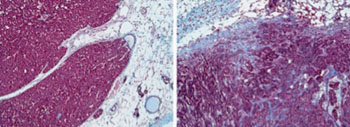Proteins in the Tumor Microenvironment Influence Progression of the Disease
By LabMedica International staff writers
Posted on 10 Jun 2015
Cancer researchers have found that factors present in the microenvironment surrounding growing tumors have important consequences as to how the disease will progress.Posted on 10 Jun 2015
Investigators at Cold Spring Harbor Laboratory (NY, USA) worked with two different breast cancer mouse models. They compared stromal components of a luminal [Mouse mammary tumor virus (MMTV)–Neu] and a triple-negative/basal-like [C3(1)–Simian virus 40 large T antigen (Tag)] genetically engineered breast cancer mouse model. While the two tumors were found in quite different microenvironments, one common factor was the presence of the extracellular enzyme Mmp9 (matrix metalloproteinase 9). Matrix metalloproteinases (Mmps) are enzymes capable of degrading most kinds of extracellular matrix proteins. They are known to be involved in the cleavage of cell surface receptors, the release of apoptotic ligands (such as the FAS ligand), and chemokine activation or inactivation. Mmps are also thought to play a major role in cellular activities such as proliferation, migration (adhesion/dispersion), differentiation, angiogenesis, apoptosis, and host defense.

Image: On the left, a breast cancer type called luminal; on the right, a type called triple-negative/basal. The luminal microenvironment has less fibrosis (scar tissue, colored purple) and contains few inflammatory cells embedded within these fibrotic areas or in the surrounding fatty tissue (white). The triple-negative microenvironment contains more inflammatory cells and more fibrosis (Photo courtesy of Egeblad Laboratory, Cold Spring Harbor Laboratory).
The investigators found that the absence of Mmp9 delayed tumor onset in the C3(1)-Tag model but had no effect on tumor onset in the MMTV-Neu model. The different response to lack of Mmp9 was found to be due to the Mmp9 substrate, insulin-like growth factor binding protein 1 (IGFBP-1). The insulin-like growth factors (IGFs) are proteins with high sequence similarity to insulin. IGFs are part of a complex system that cells use to communicate with their physiologic environment. This complex system consists of two cell-surface receptors (IGF-IR and IGF-IIR), two ligands (IGF-I and IGF-II), a family of six high-affinity IGF-binding proteins (IGFBP 1-6), as well as associated IGFBP degrading enzymes.
Results published in the May 2015 issue of the journal Neoplasia revealed that protein levels of IGFBP-1 were increased in C3(1)-Tag-lacking Mmp9 compared to C3(1)-Tag-containing Mmp9 tumors. In contrast, IGFBP-1 protein expression was low in MMTV-Neu tumors regardless of Mmp9 status. IGFBP-1 binds and antagonizes IGFs, preventing them from activating their receptors to promote cell proliferation and survival. Tumors from C3(1)-Tag;Mmp9-lacking mice had reduced IGF-1 receptor phosphorylation, consistent with slower tumor onset.
Gene expression analysis of human breast tumors showed that high expression of IGFBP mRNA was strongly correlated with good prognosis but not when Mmp9 mRNA was also highly expressed. Thus, Mmp9 had different effects on breast cancer progression depending on whether IGFBPs were expressed.
"If IGFBP-1 is not there, Mmp9 did not really have an effect, but if it is there, then Mmp9 has a role," said senior author Dr. Mikala Egeblad, an associate professor at Cold Springs Harbor Laboratory. "This suggests that IGFBP-1 interacts with Mmp9 to promote tumor formation. IGFBP-1 keeps the growth factors sequestered so they cannot act on the cancer cells and cannot make them proliferate, but if Mmp9 is present, it degrades these IGFBPs and releases the growth factors. The release of the IGFs then accelerates cancer progression. We found that IGF-binding proteins are associated with a good prognosis, but if Mmp9 is also present, there is no longer good association with survival."
"What we are starting to learn now is that the microenvironments are different in different tumors, and that there is really a very intricate interplay between what is driving the mutations in cancer cells and the type of microenvironment they build around themselves," said Dr. Egeblad.
Related Links:
Cold Spring Harbor Laboratory




 assay.jpg)








